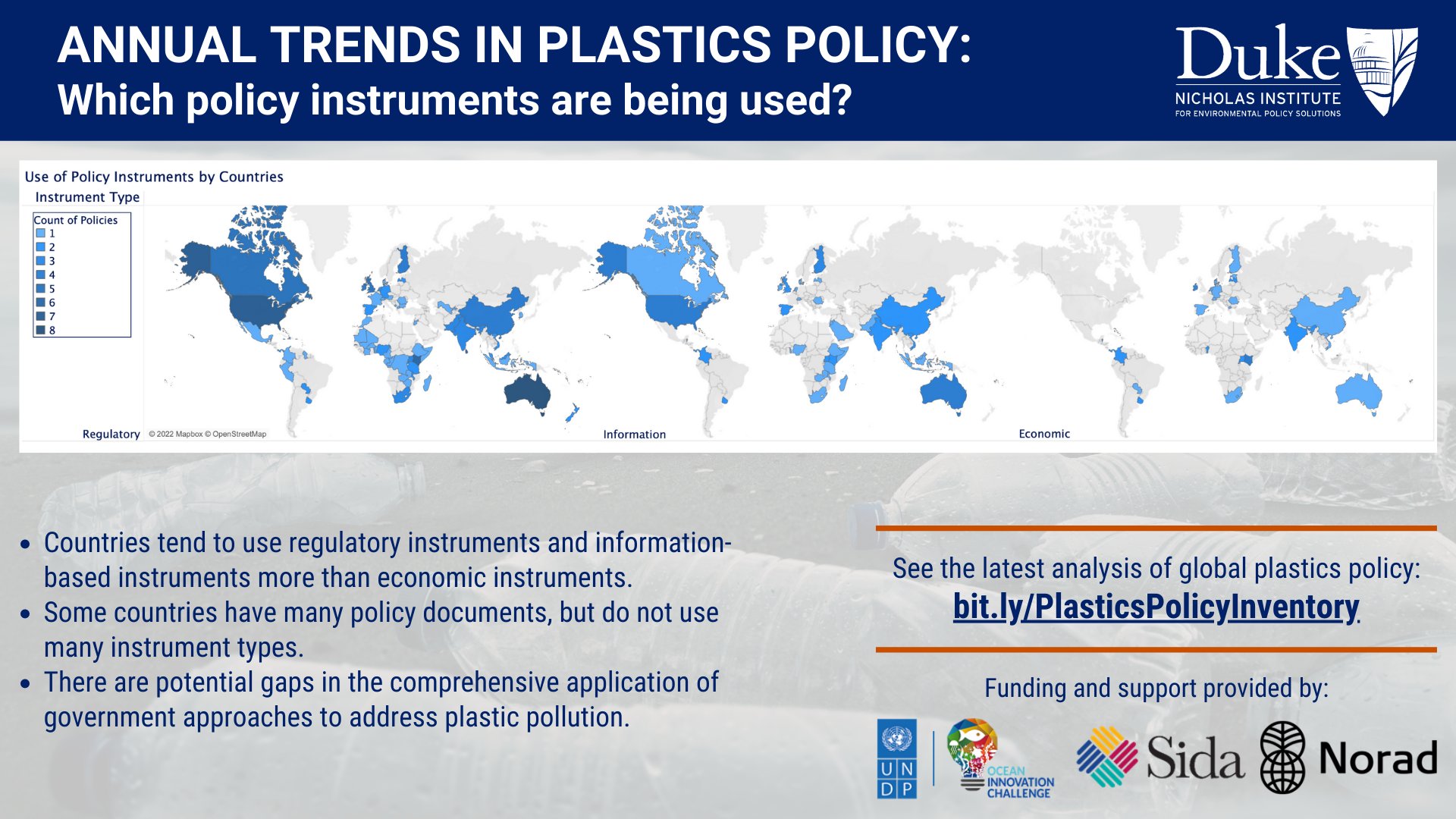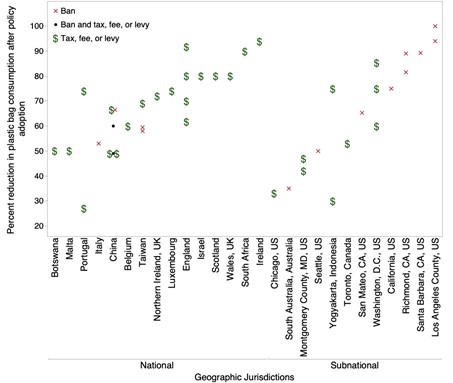How are governments responding to global plastic pollution? A glimpse of the Plastics Policy Inventory, and a COVID-19 update

Annual trends in plastics: which policy instruments are being used? (source: Nicholas Institute for Environmental Policy Solutions – Duke University)
Authors
Zoie Diana,a Tibor Vegh,b Rachel Karasik,b Janet Bering,c Madison Griffin,c Christian Laspadac, Jonathan Schachtere, Yifan Wangc, Juan Caldasc, Amy Pickleb, Daniel Rittschofa, Winnie Laud, John Virdinb
a Duke University, Division of Marine Science and Conservation, Nicholas School of the Environment, Duke University Marine Laboratory, Duke University, Beaufort, NC 28516, USA
b Duke University, Nicholas Institute for Environmental Policy Solutions, Durham, NC 27708, USA
c Duke University, Nicholas School of the Environment, Durham, NC 27708, USA
d The Pew Charitable Trusts, Washington, DC 20004, USA
e Duke University
Highlights
- 291 plastic pollution policies were compiled in a free, open-access inventory in 2020, and since then updated to include a total of 571 policies
- National and subnational policies most frequently banned macroplastics and bags
- International policies most frequently featured plans for future action
- Plastic bag policies were most commonly studied for effectiveness
- Policies on every level infrequently targeted microplastics or tire wear particles
RESEARCH BRIEF
The authors have provided an overview of government responses to plastic pollution, initially through their release of the report “20 Years of Government Responses to the Global Plastic Pollution Problem” in 2020. In this report, the authors qualitatively assessed 291 policy documents adopted between 2000 and mid-2020 to reduce plastic pollution at the international, national, and subnational levels of government all over the world, and characterized the policy instruments used and plastic types targeted in each policy. To help fill a gap in monitoring of public policies to address the plastic pollution problem, the researchers created an online, free, and searchable Plastics Policy Inventory (below referred to as the Inventory). The initial Inventory had an English-language bias that the authors have been seeking to reduce over time.
In addition, the authors recently published the article “The evolving global plastics policy landscape: An inventory and effectiveness review” in the journal Environmental Science and Policy (August 2022 issue). This article builds upon the results from the 2020 report and includes an updated review on the effectiveness of policies adopted in meeting their pollution reduction goals.
Government responses to reduce plastic pollution
Governments worldwide are adopting policies, laws, and regulations to reduce plastic pollution. This study aims to provide an overview of international, national, and subnational government responses adopted throughout the world to reduce plastic pollution (i.e., plastic pollution policies), by 1) qualitatively analyzing plastic pollution policies to characterize the policy instruments used and plastic types targeted in policies, and 2) compiling available evidence measuring the extent to which plastic pollution policies are meeting their intended goals.
The plastic pollution policies collected are available online in the Inventory. The 85 international policies included in the Inventory are deemed representative of the global landscape. The 295 national level policies in the sample are only considered indicative of the national policy landscape. The subnational level includes only an ad hoc set of 193 policies, which can serve as examples of subnational approaches to this global problem.
The Inventory and accompanying analysis have an English-language bias that the researchers are working to reduce over time through increased translation, outreach and relationship building, as well as targeted searches for and reviews of non-English policies. Across all levels of government (international, national, and subnational), governments worldwide increasingly adopted policies to reduce plastic pollution from 2000 to 2019 (Figure 1), prior to the onset of the COVID-19 pandemic.
“The Inventory can serve as a baseline for monitoring government responses to reduce plastic pollution, lay the groundwork for evidence-based plastic pollution policy-making, and contribute to the stocktaking called for under UNEA Resolution 4/6.”

Figure 1. Number of international, national, and subnational policies adopted annually during the period 2000-2019*. Figure reproduced from Diana et al., (2022).
*Policies adopted in 2020 were excluded because the dataset for that year was not complete.
International policies
Approximately 43% of the reviewed international policies featured plans or commitments for future action as instruments to reduce plastic pollution, followed by information-related instruments, including education-, outreach-, as well as research-related activities. Economic instruments (e.g., taxes, fees) were infrequently used at the international level. The most frequently targeted plastic type in international policies was the broad category of “general plastics” (40%), followed by macroplastics (25%). Notably, tire wear particles, a key source of microplastic pollution (Lau et al., 2020), were the least frequently targeted plastic type in the sample (0.5%).
“The results of the content analysis provided in this study allow governments to target gaps in the current plastics policy landscape. For example, microplastics generated from tire wear were only targeted by one policy in the Inventory (less than 1% of total policies) though are estimated to comprise 93% of global microplastic pollution (by mass) between 2016 and 2040 (Lau et al., 2020).”
National level
At the national level, governments most frequently used the following policy instruments: regulatory bans (27%), plans and commitments to future action (13%), and economic disincentives (e.g., fees, taxes, levies) (10%). On the other hand, cash-for return-systems, limits (i.e., caps or quotas on plastic production or use) that did not outright ban plastic, and tax breaks were infrequently used (<3% for each policy instrument). National policies most frequently targeted macroplastics generally (44% of the policy instruments) and bags (34% of the policy instruments). Microplastics were infrequently targeted (3%), and tire wear particles were not targeted at all.
Subnational level
In the series of examples included in the Inventory, policies introduced by subnational governments followed suit with national governments: the most frequent policy instruments used include regulatory bans (33%), followed by plans and commitments to future action (17%). Infrequently used policy instruments include cash-for-return systems, post-leakage plastic capture, limits, subsidies, and tax breaks (<1% per policy instrument).
Policy effectiveness: what’s working and what’s not
Researchers behind the Inventory surveyed the peer-reviewed literature (n=136 studies from scientific and grey literature) to determine if policies were meeting their intended goals of reducing plastic pollution, and synthesized recommendations to policymakers on how to improve outcomes of plastics policies. Of the reviewed studies, the team found 40 that reported quantitative or qualitative outcomes of the policy adopted. Most articles studied the effectiveness of plastic bag bans and/or fees, with outcomes ranging between 27-100% reduction in plastic bag consumption compared to prior policy adoption (Figure 2). The time between policy adoption and the publication of a peer-reviewed article presenting results of the policy effectiveness was on average 6.5 years for the publications reviewed.

Figure 2. Percentage reduction in plastic bag consumption after national or subnational policy adoption as compared to prior policy adoption. The following are abbreviated: United States (US), California (CA), Maryland (MD), United Kingdom (UK), and District of Columbia (D.C.). Figure reproduced from Diana et al., (2022).
Most studies reviewed used a simple difference approach to measure outcomes from policy adoption. In brief, authors of the studies measure the outcomes before and after policy adoption in the geographic area where a given policy was adopted. Only five studies reviewed (Berck et al., 2016; Homonoff et al., 2018; Homonoff, 2018; Rivers et al., 2017; Taylor and Villas-Boas, 2016) used causal inference approaches to link outcomes observed (e.g., plastic bag consumption reductions) to policy adoption.
The researchers behind the Inventory also synthesized recommendations made to policymakers across the reviewed body of literature on how to improve plastics policies. Recommendations that were consistently noted in the literature are presented (Table 1).
Table 1. Recommendations for improving policies to reduce plastic pollution as compiled from the reviewed literature. Table reproduced from Diana et al., (2022).
| Plastic type | Recommendation |
|---|---|
| Land-based sources | Implement a binding global treaty that has a specific and measurable target(s) |
| Increase use of information instruments (e.g., education and outreach) | |
| Improve solid waste management systems, especially in low and middle-income countries | |
| Extend producer responsibility | |
| Plastic bags | Use a combination of instruments, especially education and outreach paired with economic instruments |
| Do not ignore consumer behavior shift (i.e., leakage) to use disposable alternatives to plastic bags (e.g., paper bags) | |
| Set plastic bag fees high enough to decrease consumption | |
| Single-use macroplastics (excluding bags) | Apply regulatory bans, typically used on plastic carrier bags, to other single-use plastics (SUPs), at least in the short-term |
| Apply instruments that give consumers cash for returning used SUPs for recycling | |
| Microplastics | Ban microbeads in all cosmetic and personal care products at all levels of government |
Through this research, the team behind the Inventory aims to continue tracking government responses and other solutions to plastic pollution across decision-making levels, and to strengthen the evidence base for the design of future policies, such as the recently adopted resolution “End Plastic Pollution: Towards an International Legally Binding Agreement”. Through continued support from the United Nation’s Development Program’s Ocean Innovation Challenge, the research team for instance expanded the Inventory from an initial 291 plastic pollution policies to 571 policies in 34 languages, as of December of 2021.
From this updated review and enhanced Inventory, the research team authored the annual update and brief “Annual Trends in Plastics Policy: A Brief”. This recent policy brief updated the Inventory to include policies passed in 2020 and 2021. Findings from this brief indicate that some governments may have put the adoption of new policies to reduce plastic pollution on hold during the COVID-19 pandemic. Although the brief lacks causal evidence, our findings are consistent with reports that many governments worldwide, including in China, France, India, Italy, Portugal, Sardinia, Scotland, Spain, Myanmar, and the United States rescinded existing policies adopted to reduce plastic pollution and/or delayed the adoption of new policies during the COVID-19 pandemic (Patrício Silva et al., 2020).
Full publication available here.